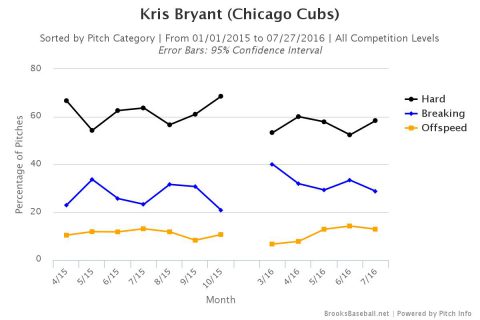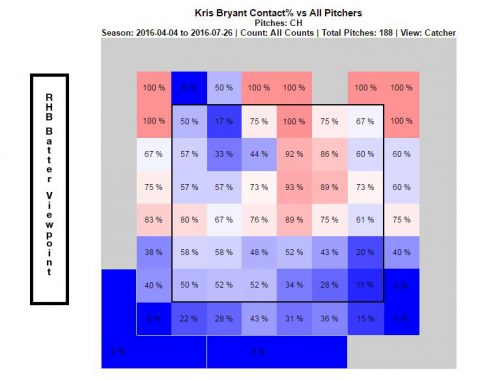With the Chicago Cubs set to wrap up the National League Central in the coming days/weeks, it’s looking more and more difficult for anyone to make a case that will topple that of Kris Bryant for the National League Most Valuable Player Award. That hasn’t stopped some from trying, and there are cases to be made for a small handful of players outside of the Chicago third sacker. One of those potential finalists could be one of Bryant’s third base counterparts, in Colorado Rockies third baseman Nolan Arenado.
Our job here isn’t necessarily to decide that debate. While it does look like Bryant is currently the frontrunner, there are numerous factors to be considered in regard to the MVP beyond the offensive numbers which we will illustrate here. There’s defense to be considered as well as versatility, WAR, etc. That’s almost another debate entirely. Here, we’re only worried about the offense. So let’s delve into some of the numbers for a pair of extraordinary National League players.
Heading into Tuesday’s slate of games, here’s how the two stacked up in a general sense:
|
AVG |
OBP |
OPS |
ISO |
K% |
BB% |
wRC+ |
| Kris Bryant |
.305 |
.402 |
.988 |
.281 |
21.9 |
11.3 |
160 |
| Nolan Arenado |
.293 |
.362 |
.939 |
.285 |
13.1 |
10.1 |
125 |
The general perspective would certainly seem to favor Bryant in most regards. He reaches base at a far higher rate, while notching an OPS that comes in almost 50 points higher than Arenado. In regard to ISO, the two are tied in home runs, while Bryant leads in doubles. It’s Arenado’s four triples that give him an edge there. But even the higher K rate for Bryant doesn’t make this a win for Arenado, considering everywhere else on the board that Sparkle Eyes has an edge. At the same time, we’re comparing two elite players here. The numbers are going to look great anyway you slice it. While we could certainly make a judgment about which is more valuable based off of this information alone, let’s dig just a bit deeper. Spoiler alert: we’re going to the splits.
Home/road splits tend to always be Arenado’s undoing. Playing at Coors Field is both a blessing and a curse in that regard. While nobody is questioning his offensive potency overall, it’s hard to ignore the disparity in production between his home and road splits:
|
AVG |
OBP |
OPS |
ISO |
K% |
BB% |
wRC+ |
| Arenado (Home) |
.317 |
.390 |
1.052 |
.346 |
11.2 |
11.2 |
136 |
| Arenado (Away) |
.270 |
.336 |
.832 |
.227 |
14.9 |
9.0 |
115 |
At Coors, Arenado is predictably off the charts. His ISO is, to use a technical term, stupid when he’s playing in the confines of his home ballpark. But there isn’t a statistic here that doesn’t experience significant decline when he steps out of Denver. In most respects, the road numbers are still impressive, but not so much that they don’t still take away from the total body of work. Hooray for double negatives.
Conversely, Bryant has posted more impressive numbers on the road than at the Friendly Confines:
|
AVG |
OBP |
OPS |
ISO |
K% |
BB% |
wRC+ |
| Bryant (Home) |
.276 |
.375 |
.910 |
.259 |
24.5 |
9.7 |
142 |
| Bryant (Away) |
.332 |
.425 |
1.058 |
.301 |
19.6 |
12.7 |
176 |
The favorable road split is something I touched on earlier this season, and it’s a trend that hasn’t exactly dissipated as the season has worn on. Even with that more impressive road split in mind, it’s hard not to look at that home line and still be overwhelmingly impressed. While there’s a clear decline, he still maintains a higher level in almost every single respect above Arenado, strikeout rate notwithstanding. So to this point, the general overview and the splits both seem to favor Bryant.
To some degree, consistency should be taken into account, illustrated below with Arenado’s wRC+ throughout the season, followed by Bryant’s:

And Bryant…

Obviously, with the scope of each graph, there’s going to be the appearance of a great deal of fluctuation. And it’s hard to put too much stock into the day-to-day happenings of the wRC+ world. At the same time, this does provide a nice visual when considering each player’s total offensive value in a more intricate sense. Just as the splits did, this would also appear to favor Kris Bryant, as the actual variation in his wRC+ is not nearly as significant. Perhaps more importantly, Bryant has managed to exclusively stay at or above that 100 mark since the very beginning of the season, something Arenado has not accomplished.
If we were going to take this debate out of the fantasy arena and put it on the MVP plane, then we’re bringing in other factors. Defensively, the edge would probably go to Arenado. But you also have to take defensive versatility into account, as Bryant moves around the diamond and is still an above average defender wherever he is. Sparkles in the eyes? Game: Bryant. It’s a really fascinating debate, and one that will likely continue as the regular season winds down. But for our purpose here of examining that offensive value, and thus assessing their fantasy relevance in a very general sense, the edge has to go to the Chicago Cubs superstar.
And obviously none of this is meant to disparage Nolan Arenado. He’s a supremely talented offensive player and one of Major League Baseball’s elite. But when we’re talking offense and offensive value, there is not a shred of doubt in my mind that the edge, in almost every single respect, goes to Kris Bryant.








